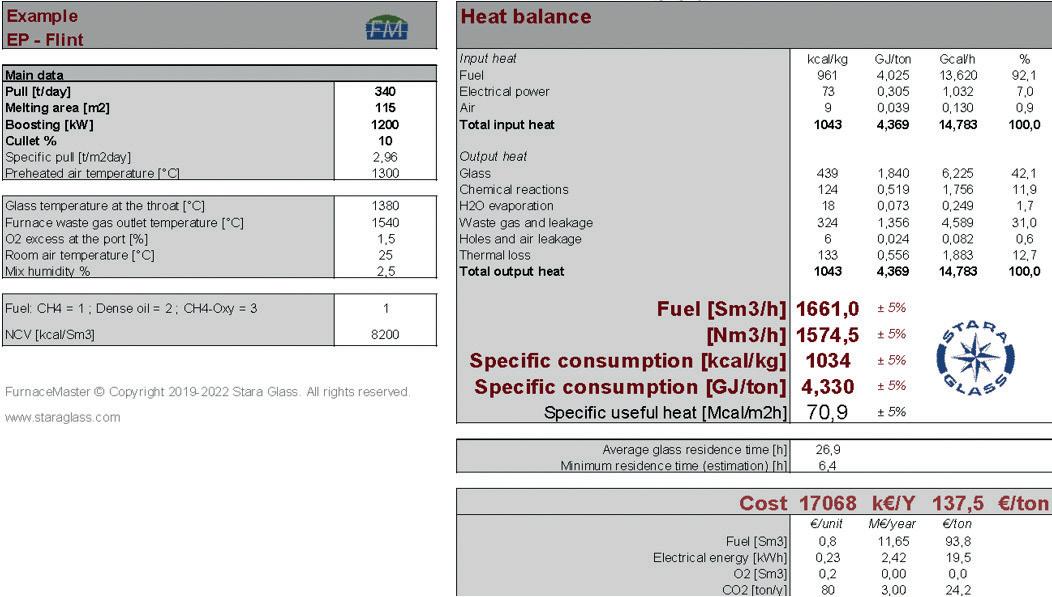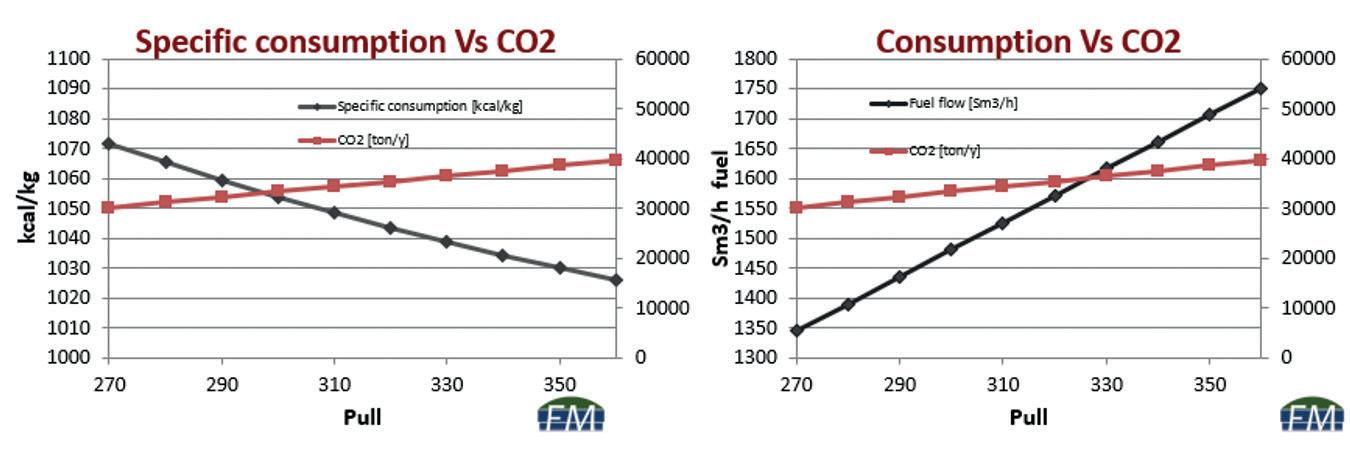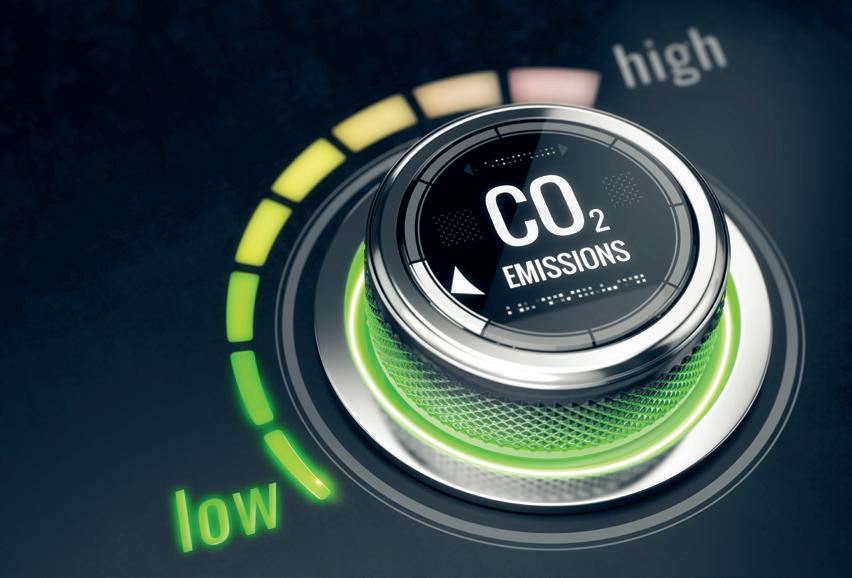
7 minute read
Decarbonisation: Stara Glass
Decarbonising regenerative glass furnaces
Ernesto Cattaneo* and Annick Lachance Nyiringango** investigate how operating conditions affect the amount of CO2furnace, while observing operating costs. emitted by a regenerative glass
The glass industry contributes significantly to CO2 emissions - 5% of European production according to European Union Emissions Trading System (EU ETS). Therefore, the industry is committed to participating in the global initiative to reduce them.
CO2 emissions during glass production originate from two sources and only a small portion comes from batch chemical reactions. The remainder, easily more than 80%, is caused by fossil fuels. They are burned to heat furnaces, due to the high temperatures required to melt the raw materials used to make glass.
Though, in the process of designing a glass furnace, there are many unchangeable boundaries set by production needs which deeply affect the furnace performance, the designer has few but powerful operative leverages.
Several years ago, Stara Glass published an article describing how the process parameters impact the furnace consumption. In the light of the decarbonisation movement, we propose a similar evaluation, focused on the CO2emission.
In this article, we will explore the influence of operating parameters on the CO2 emissions, consumption, and operating costs. The parameters will be measured through FurnaceMaster, a software designed by Stara Glass. It allows the designer to precisely define all computing input and collect all the significant output.
Assumptions
For our study, the following consumption costs are assumed:
Fuel cost [€/Sm3] 0.8 Electric energy cost [€/kWh] 0.23 CO2 [€/ton] 80
Fig 1. Inputted nominal data in � FurnaceMaster from a regenerative furnace producing container glass.
Nominal data
Fig 1 shows inputted nominal data in FurnaceMaster, given a state-of-the-art regenerative furnace producing container glass. Since the glass is white, the cullet is considered to be 10 to 60%.
Studied Parameters
The parameters below (table 1) will be individually varied in the analysis; their impact on CO2 emissions will be evaluated. We will also look at the fuel consumption, specific consumption, and production cost in table 2.
Results
Pull
Figs 2 and 3 have been obtained by changing the pull while keeping the rest of the input parameters constant. We assumed the nominal point at 340 tpd and, for the purpose of this article, we did not change the electrical energy utilisation. Such parameters would have been changed in common furnace operational practice.
Results show that the more the pull increases, the more CO2 is emitted and the more the consumption and operating costs are. Though, at the same time, specific consumption decreases together with quality expectations, which is connected to the minimum residence time rather than to the average, which is steadily defined by pull and furnace geometry.
We therefore observe that, to limit specific CO2 emissions, we need to use large furnaces at their highest pull.
Oxygen content
Fig 4 considers the oxygen content in waste gas at the port. It shows that the higher the oxygen excess at the port, the higher the CO2 emitted. Higher oxygen excess also means more consumption and operating costs.
However, the theoretical curve does not consider the following: � At very low O2 level, combustion is not complete, and a certain quantity of CO is formed. � Different levels of O2 correspond to different waste gas and air volumes.
Input
Parameter Driver Notes
Pull [t/day] O2 excess at the port [%] Boosting [kW] Cullet % Set by the glassmaker based on production needs. The more stable it is, the more effi cient the furnace will be. Environment, materials, consumption, and quality. It is used for balancing undesired productions of CO and NOx. Investment It is always useful for quality and capacity but it also increases the production cost
Production and colour.
Remarkably impacts consumption. Mix humidity % Production, geographical position, storage method. Remarkably impacts consumption. Preheated air temperature [°C] Available space / design The higher, the better.
Table 1
Output
Parameter Notes CO2 Emission [Ton/Year] Gas consumption [Sm3] Specifi c consumption [kcal/kg] Production cost [€] It increases with energy consumption. It increases with the pull. It decreases when the pull increases and with the usage of electrical power. It decreases with a larger utilisation of electrical boosting.
Table 2


Fig 2. The table shows what happens to the parameters when the pull is changed.�

� Fig 3. Results in the graph show that the more the pull increases, the more CO2 is emitted.
� The higher the volumes are in the chambers, the higher the heat effi ciency will be, but the lower the temperature effi ciency of the chambers.
Nowadays this parameter is more under the spotlight for its connection with NOx and CO production rather than for its energy implications, but energy implications are important as well. To contain consumption and CO2 emission, we have to burn as stoichiometric as possible.
Boosting
Fig 5 shows the effect of increasing boosting from 600 to 2000 kW on the parameters.
The heat coming from the boosting is directly transferred to the glass heating it up with a better effi ciency. Therefore, increasing boosting corresponds to decreasing the specifi c consumption, fuel consumption, and CO2 emissions.
Some barrier boosting is usually benefi cial for the right formation of two opposing convective cells in the glass batch. Nevertheless, overuse of boosting may compromise the correct thermal profi le of the superstructure and production itself. Also, an increase in boosting means extra production costs.
While a high boosting decreases a furnace’s CO2 emissions, it has to be kept in account that the average fuel effi ciency of a regenerative furnace is about 65%, while an average fossil power plant is 45%. Therefore, unless the electricity used in the furnace comes from renewable sources, more boosting means more CO2 in the environment.
Cullet
Using glass cullet reduces CO2 emissions as it reduces furnace consumption considerably. Cullet represents a portion of the glass mix that does not require the heat needed to transform raw materials into glass.
According to Fig 6, using 90% cullet reduces CO2 emissions by more than half. Less CO2 is emitted because melting cullet requires less energy.
However, external cullet utilisation is not an option for high quality extrawhite glass.

� Fig 4. The table shows that the higher the oxygen excess at the port, the higher the CO2 emitted.
� Fig 5. The table shows that increasing boosting corresponds to decreasing CO2 emissions.
� Fig 6. The results show that using glass cullet reduces CO2 emissions significantly.



� Fig 7. The table shows that increasing mix humidity increases CO2 emissions.
Overall, the higher the cullet, the lower the CO2 emission.
Mix Humidity
Fig 7 shows the effect of increasing mix humidity from 1.5 to 5% on the parameters.
Increasing mix humidity increases CO2 emissions caused by increased furnace consumption. This is because the batch mix water absorbs heat to become steam and reach waste gas temperature.
In fact, a covered storage area for raw materials can be a very beneficial investment. A low mix humidity, on the other hand, frequently promotes carry over problems.
Air Temperature
Fig 8 shows the effect of increasing air temperature from 1150 to 1350°C on the parameters.
An increase in air temperature means the reduction of consumption and CO2. This temperature can be increased at the highest level possible to increase furnace efficiency.
A contemporary melting glass furnace needs a performing heat recovery system.
Glass Temperature
Fig 9 shows the effect of increasing glass temperature at the throat from 13401420°C on the parameters.
Increasing glass temperature obviously means more consumption and consequently more CO2 emissions.
To reduce the CO2 emitted, this parameter can be maintained at the lowest level possible depending on the type of production and glass colour desired.
Conclusions
Glass furnaces are complex systems. Their performance in terms of energy, environmental performance, and glass quality is dependent on a range of characteristics.
However, there is still room for the designer to affect the reduction of CO2 they emit. For this transformation to be effective, it is critical to examine the desired glass quality as well as the cost of production.
To achieve decarbonisation, less energy should be consumed.
Among all the parameters that reduce energy consumption, cullet stands out as a parameter that can have a significant impact on the amount of CO2 released by the furnace; the more glass that is recycled and used in the furnace, the more efficient the furnace is, and less CO2 is emitted.
In fact, we have a message for glass producers: as humans, we surely prefer to drink our spirits and buy our perfumes in slightly green containers than to aggravate the climate emergency. �
*Head of Innovation Department, **R&D engineer for SGRPRO, a Stara Glass affiliate, Stara Glass, Genova, Italy https://www.staraglass.it/


� Fig 8. The results show that an increase in air temperature reduces CO2 emissions.

� Fig 9. The table shows that increasing glass temperature increases CO2 emissions.










